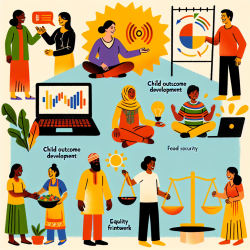Introduction
In the realm of speech-language pathology, the importance of creating equitable and effective communication strategies cannot be overstated. The recent research article, "Coalition Building and Food Insecurity: How an Equity and Justice Framework Guided a Viable Food Assistance Network," provides valuable insights into how coalition building and community organizing can lead to systemic changes. These principles can be adapted to improve outcomes in speech-language pathology, particularly in online therapy services like those provided by TinyEYE.
Understanding Coalition Building and Equity Frameworks
The research highlights the success of the Greater New Haven Coordinated Food Assistance Network (CFAN), which utilized the Collaborating for Equity and Justice (CEJ) framework. This framework emphasizes cross-sector collaboration with a focus on equity and justice, ensuring that all voices, especially those of underserved communities, are heard and valued.
By applying similar principles in speech-language pathology, practitioners can foster inclusive environments that prioritize equitable access to therapy services. This involves actively engaging with diverse stakeholders, including families and educators, to create a comprehensive support system for children requiring speech therapy.
Implementing Coalition Building in Speech-Language Pathology
To effectively implement coalition building in speech-language pathology, consider the following strategies:
- Engage Diverse Stakeholders: Involve families, educators, and community organizations in the therapy process to ensure a holistic approach to child development.
- Focus on Equity and Justice: Develop therapy plans that address the unique needs of each child, particularly those from underserved communities, to promote equitable access to resources.
- Foster Collaboration: Encourage collaboration among therapists, educators, and families to share best practices and resources, enhancing the overall effectiveness of therapy services.
- Utilize Data-Driven Decisions: Collect and analyze data to identify gaps in service delivery and implement targeted interventions that address these issues.
Encouraging Further Research
The success of CFAN in addressing food insecurity through coalition building serves as a model for similar initiatives in speech-language pathology. Practitioners are encouraged to explore further research on coalition building and equity frameworks to enhance their practice. By doing so, they can contribute to the development of more inclusive and effective therapy services that cater to the diverse needs of children.
Conclusion
Incorporating coalition building and equity frameworks into speech-language pathology can lead to significant improvements in therapy outcomes for children. By engaging diverse stakeholders, focusing on equity, fostering collaboration, and utilizing data-driven decisions, practitioners can create a more inclusive and effective therapy environment.
To read the original research paper, please follow this link: Coalition Building and Food Insecurity: How an Equity and Justice Framework Guided a Viable Food Assistance Network.










